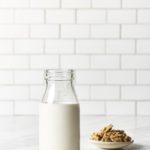Walnut Milk
January 28, 2018
Have you tried homemade walnut milk? It is so delicious, loaded with nutrients, and is vegan (dairy -free), gluten-free, and paleo friendly.

Walnut Milk
This walnut milk is super easy, is rich and creamy, incredibly delicious, and is vegan (dairy -free), gluten-free, and paleo friendly.
Prep Time 10 minutes
Total Time 10 minutes
Servings 3 1/2 cups
Ingredients
unsweetened walnut milk:
- 1 cup raw walnuts, soaked for 8 hours
- 3 cups filtered water
- Pinch of Celtic sea salt
sweetened milk (unsweetened milk, plus below):
- 1 teaspoon natural vanilla extract
- 3 to 4 pitted dates (or 2 to 3 tablespoons pure maple syrup or other sweetener)
- 1 tablespoon sunflower lecithin (optional)
Instructions
-
To soak the walnuts, place the nuts in a glass or ceramic bowl or large glass jar, and cover with filtered water. Add 1/4 teaspoon Celtic sea salt and splash of fresh lemon juice or apple cider vinegar, cover the container with a breathable kitchen towel, and allow to soak at room temperature for 12 hours. (For more information on soaking read here.)
-
Drain, and discard the soaking liquid (do not use this to make the milk). Rinse the walnuts several times to remove the anti-nutrients and enzyme inhibitors.
-
Throw the rinsed walnuts, water, and salt in your blender, and blast on high for 30 to 60 seconds, until the nuts are completely pulverized. Use whole milk to maximize nutrition. Or strain for a smoother, more commercial-style milk for use in recipes.
-
To strain, place a nut milk bag or knee-high piece of sheer nylon hosiery over the opening of a glass bowl, jar or jug. Pour the milk into the bag, twisting the bag closed, and gently squeezing it to pass the liquid through. Empty the walnut pulp aside. You can dehydrate this for use in smoothies or to make crusts. Or make this quick easy body scrub.
-
Rinse your blender container, and pour the strained milk back in. Add the vanilla, sweetener, and lecithin (if using), and blast again, until smooth and creamy.
-
Store the milk in a sealed container in the fridge. Activated walnut milk (made with soaked walnuts) will keep for 2 to 3 days in a very cold fridge. Unsoaked walnut milk will keep for about 5 days.
Recipe Notes
Learn more about making homemade milks
Photo by Trent Lanz; styling by Alicia Buszczak








